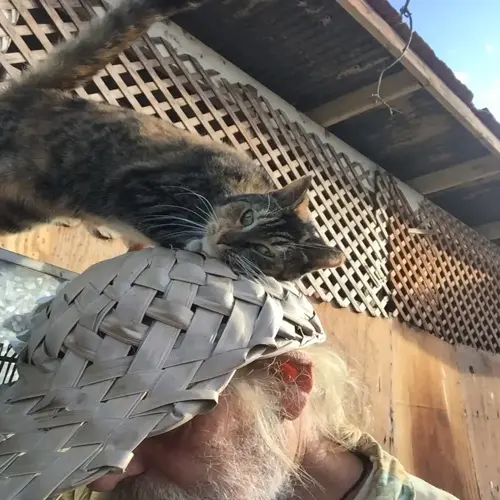Choosing the Right Cat Carrier Size Guide

Written by
Victoria Hayes
Reviewed by
Prof. Edward Clarke, Ph.D.Correct cat carrier size prevents injuries and reduces travel anxiety for felines
Measure your cat's length plus 4 inches for minimum carrier dimensions
Hard plastic carriers provide maximum safety for cats over 15 pounds
Always include dual-entry points and 360° ventilation in carrier setup
Practice 4-week progressive training to create positive carrier associations
Avoid oversized carriers - they increase stress and injury risks
Article Navigation
The accuracy of cat carrier size is crucial for your cat's safety and comfort during travel. Many owners accidentally select carriers that are too large or too snug. Both errors create anxiety. A correctly sized carrier will protect your cat and ease panic.
Accurate measurements prevent injuries and escapes before they happen. Accurately measure your cat. Do not guess. We will show you how to find the perfect carrier size. Your cat deserves a completely stress-free trip every time you travel together.
Why Cat Carrier Size Matters
Using the wrong cat carrier size can create a serious physical threat to your cat's safety. If the carrier is too small, there will be difficulty breathing as panic cases develop. If the carrier is too large, your cat will slide dangerously during travel. However, the right amount of space in a carrier will create a sense of security for your pet.
Excessive space in carriers harms the mental health of cats. Veterinarians indicate that cats often feel vulnerable and exposed in large spaces, and they tend to feel more secure in confined areas. The right size has a pronounced impact on anxiety during travel. Your cat will be calmer on visits to the veterinarian.
Appropriate sizing impacts cat safety in transit. A correctly measured carrier lessens escape and injury. Cats can brace themselves for sudden stops in the vehicle. Stressed cats relax as soon as they are in a well-fitting carrier. Measure carefully for proper peace of mind.
Measuring Your Cat Correctly
While your cat stands, measure its length from the tip of its nose to the base of its tail. Add 4 inches for the minimum carrier length. Measure its height from the floor to the top of its head. Add 4 inches for height clearance. This +4 inch rule will also assure you enough room for safety in its movements.
Don't forget about weight restrictions if you care for the safety of your carrier. Check the maximum capacity of your carrier. Weigh your cat on a scale in your bathroom. Weigh yourself first. Then pick up your cat and weigh again. You subtract your weight. This prevents the carrier from overloading, which could cause structural collapse during transit.
To ensure the right measurement of struggling cats, try this sleep position for accuracy. Wait until your cat is in a deep sleep. Gradually, take some measuring tape and position it along your cat's body. With quickness, record the dimensions before your restless cat awakens. This prevents your cat from wiggling to make probable errors.
Correct carrier sizing should begin with accurate measurements. I always recommend that owners measure three times and write down the highest numbers. Don't forget to include fur thickness if your cat has long hair. These details impact your cat's comfort.
Choosing the Right Carrier Type
Choosing the right pet carrier type involves matching the carrier's strength to your travel needs. Hard plastic carriers give the best protection for air travel and for nervous cats. They are so rigid that pets inside cannot be crushed. Soft carriers are suitable for house cats that only require short trips to the vet.
Obey strict weight limits for each carrier type. Hard, rigid carriers are safe for holding cats weighing 5-25 lbs and over. Soft-sided carriers are not suitable for cats that weigh over 15 pounds. Tipping hazards can occur on flat surfaces with rolling carriers.
Roller carriers have restrictions on the type of ground. They are suitable for clean airport floors or pavement. Stay off gravel, grass, or areas with poor sidewalks. The wheels easily get jammed on rough ground. I have seen cats become frightened when the carriers tilt suddenly.
When selecting a carrier, carrier durability and travel safety are the most important factors. Durable plastic will withstand baggage handling; however, soft materials can tear when passengers are experiencing a panic attack or as the pet is being extracted from its area. Always check for airline approval stickers. Your cat's safety depends on these decisions.
Carrier Setup for Safety & Comfort
Carrier safety necessitates certain irreducible elements: for instance, dual entrances, and 360° ventilation. The upper openings allow for emergency access during panic attacks. Proper air circulation prevents overheating and the risk of suffocation. Always check the latches before travel. These features can save lives in times of emergency.
Maximize means of travel comfort by using proper lining methods. Use machine-washable towels with home fragrance. Apply the pheromone spray 30 minutes before placing the cat in the carrier. After the proper amount of time has passed, the scent has had time to be absorbed. Do not spray the substance directly on surfaces your cat may contact.
Fasten carriers in vehicles to minimize sliding injuries. Insert seatbelts through the carrier handle in flat-back seats, and position a non-slip mat beneath. Do not use the front seats, as there are dangers associated with the airbags. Cover with breathable ware to minimize visual anxiety.
A good setup will make what could be a frightening ordeal manageable. I always carry an extra towel in case of an accident. Ensure that airways are not obstructed by bedding. Your cat will appreciate your due diligence.
Interior Lining
- Use absorbent towel or blanket for comfort and accident absorption
- Avoid thick bedding that reduces interior space dimensions
- Place familiar-smelling item to reduce anxiety during travel
- Ensure material is machine-washable for easy cleaning post-trip
Pheromone Application
- Apply pheromone spray on bedding 15-30 minutes before loading cat
- Avoid direct application on cat or carrier surfaces causing residue
- Reapply every 4-6 hours during extended journeys
- Test spray on small area first if cat has sensitive skin
Safety Features
- Confirm dual-entry points (top/front) for easy access
- Check all latches function properly before each trip
- Ensure 360° ventilation with unobstructed airflow
- Add temporary ID tag with contact info during travel
Vehicle Securing
- Use seatbelt through carrier handles in back seat only
- Place carrier on flat surface to prevent tipping
- Avoid direct air vents or sunlight exposure positions
- Cover carrier with light breathable cloth for darkness
Pre-Travel Checks
- Verify weight capacity exceeds cat's current weight
- Inspect for cracks, loose screws, or weak points
- Practice opening mechanisms with gloves (simulating stress)
- Do trial run with cat 24 hours before actual trip
Training for Stress-Free Carrier Use
The 4-week progressive acclimation plan gradually builds comfort with carriers rather than being fearful of them. In the first week, the cat will explore the airline and find treats inside. Limit sessions to 5 minutes and never exceed the stress level. This will build the positive associations gradually.
Become proficient in the towel wrap method, which is useful in emergencies. Drape a large towel over your cat completely. Place gentle upward pressure upon the shoulders to prevent escape. Create a scoop and fold in the edges of the towel underneath. Place feet first into the carrier promptly. This technique prevents scratching and panic.
Consistency makes training successful. Have training sessions every day. Don't miss training sessions. Use high-value rewards, such as chunks of chicken or tuna flakes. Never force your cat. Allow your cat to choose their own pace in the program. You will then experience a lasting reduction in stress.
Follow the complete acclimation plan to achieve the best results. Week two involves closed-door meetings. Week three introduces short carries. Week four contains mock car rides. Monthly repeats keep positive associations. You'll be rewarded for your patience with less hectic visits to the vet.
Preparation
- Use large bath towel (not small hand towel)
- Approach cat calmly from behind during quiet time
- Avoid eye contact to reduce perceived threat
Wrapping Steps
- Drape towel completely over cat's body and head
- Apply gentle pressure on shoulders to prevent escape
- Scoop cat while folding towel edges underneath body
- Immediately place wrapped cat into carrier feet-first
Aftercare
- Cover carrier with light cloth to maintain calm
- Offer high-value treats after veterinary visit
- Never use wrap method for non-emergencies
5 Common Myths
Larger carriers offer better comfort for cats while transporting
Oversize carriers cause anxiety due to open spaces creating sense of insecurity and an accident and safety hazard. The cat feels exposed exposed without cushioned barriers causing additional stress and the risk of injury from movement during transport. Properly sized crates will enable cats to brace themselves firmly and at the same time offer a sense of enclosure which will lessen panic response.
Backpack-style carriers enable cats to experience lovely sights while on walks.
However, backpacks can limit normal movement patterns and lead to travel sickness from the constant swaying. They restrict natural posture and do not allow for adequate ventilation, which leads to dangerous overheating. Veterinarians who specialize in behavior see panic responses in cats who go in and out of carriers in brief experiences, which belies the claim that these experiences are enjoyable at all.
Flexible carriers offer reasonable safety for ordinary household cats.
Flexible carriers are easily torn, under claw pressure during panic episodes, leading to attempts to spring free. They offer little protection from shock, due either to impact from sudden vehicle currents or accidental drops of a flexible object such as a flexible carrier, but securely fastened to a seat. Their flexible structure prevent fastenings from being made, in the vehicle, in which they are concerned, as well, therefore, as insufficient rigidity leading to failture under International Air Transport Association safety requirements.
Cats are naturally inclined to travel in the same carriers with other cats
Forced closeness in confining situations is most often associated with territorial aggressiveness and extraordinary stress. Sharing difficulties monitoring individual health status during transit, and markedly increase risk of overheating. Veterinary associations agree as a rule that separate carriers must be utilized except in the case of bonded pairs accompanied by the appropriate bonding instruction and acclimatizing training.
Ventilation holes are provided more for decorative than for other reasons.
Sufficient air current is essential to prevent dangerous overheating and suffocation from lack of oxygen while in transit and to prevent conditions of danger from distress in a few minutes. The minimum mesh surface required by the IATA and USDA for the type of kennel being used is 16 per cent. Properly located ventilation holes are necessary to assure survival under extreme temperatures and to prevent accumulation of carbon dioxide during protracted transit.
Conclusion
The size of the cat carrier is non-negotiable when it comes to feline safety and well-being. The measurements should not be flexible. Correct sizes prevent your cat from being injured or attempting to escape when being carried. The proper size provides a safe space for your cat where he will be more likely to stay calm and secure.
With consistent carrier training, the horrible experience of going to the vet becomes a tolerable experience. The four-week program gradually creates positive associations. Your cat will learn that their carrier means safety, not fear. This stress reduction means the visits to the vet are not quite so traumatic for everybody.
The proper environment leads to higher visit success rates. Adequate airflow and secured cages prevent emergencies. Use of pheromone sprays and familiar bedding helps reduce stress. I have found that cats arrive more relaxed, which allows them to be examined more quickly, and the health outcome is better.
Creating informed decisions regarding carriers helps build lasting travel confidence. Measure accurately. Train slowly. Prepare thoughtfully. Your investment of time creates safer and happier journeys. Start following these steps today for an easy journey with your feline.
External Sources
Frequently Asked Questions
How do I measure my cat for the right carrier size?
Measure from nose to tail base and floor to head top while standing. Add 4 inches to both dimensions for minimum space. Always verify carrier weight capacity exceeds your cat's current weight. Use bathroom scales for accurate weight checks before purchasing.
What carrier type is safest for air travel?
Hard plastic carriers meet international air travel safety standards due to their rigid structure. They prevent crushing during cargo handling and provide superior ventilation compared to soft-sided options. Their secure latching systems also minimize escape risks during turbulent flights.
How can I make my cat comfortable in the carrier?
Use these proven techniques:
- Line with machine-washable bedding carrying familiar scents
- Apply pheromone spray 30 minutes before travel
- Include favorite small toys for distraction
- Practice gradual carrier acclimation over 4 weeks
Why do cats resist entering carriers?
Cats associate carriers with stressful vet visits or travel. Their natural instinct views confined spaces as potential traps. Past negative experiences create lasting fear responses. Proper training using positive reinforcement can rebuild positive associations over time.
Where should I place the carrier in my vehicle?
Secure carriers on back seats using seatbelts through handle loops. Ensure the carrier sits flat without tilting. Avoid direct sunlight or air vent exposure. Position away from airbags and never in footwells where movement is restricted.
How do I handle emergency carrier loading?
Use the towel-wrap method:
- Drape large towel completely over cat
- Apply gentle shoulder pressure to prevent escape
- Scoop while folding towel edges underneath
- Place feet-first into carrier immediately
Should I cover the carrier during travel?
Yes, use light breathable cloth covers to reduce visual stress. This creates a den-like environment cats find comforting. Ensure material allows full airflow and doesn't trap heat. Remove immediately if panting or distress signs appear.
How often should I retrain my cat to use the carrier?
Conduct monthly refresher sessions even after initial training. Practice increases include:
- 5-minute closed-carrier sessions weekly
- Short walks around home quarterly
- Mock car rides biannually
- Always reward with high-value treats
Are soft-sided carriers ever safe?
Soft carriers pose significant risks:
- Tear easily during panic episodes
- Lack structural integrity in accidents
- Inadequate ventilation during warm weather
- Fail international safety certifications
- Only suitable for calm cats on short vet visits
What ventilation standards should carriers meet?
Carriers require minimum ventilation coverage equivalent to mesh panels on all sides. Proper airflow prevents life-threatening overheating and oxygen deprivation during transport. International standards mandate ventilation covering at least surface area percentage to ensure cat safety in various temperatures.

